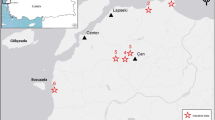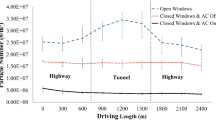Abstract
The Eurasia Tunnel, a 5.4-km tunnel connecting the Asian and European sides of Istanbul, Turkey, was opened for operation in December 2016. This paper describes the air quality modeling that was conducted during the design phase of the structure, to evaluate the impact of the tunnel traffic on ambient air quality in the vicinity of the tunnel. The ventilation of the tunnel consists of longitudinal forced ventilation with vertical extraction through two stacks located near the Asian and European portals of the tunnel. The analysis was conducted using the AERMOD computer program for three pollutants CO, NO2, and PM10. Model results show that pollutants will rapidly disperse once released from the stack and will not affect air quality in the vicinity of the tunnel. The most critical parameters which controlled the ventilation system design were found to be NO2 and PM10. Maximum concentrations are not expected to violate the pertinent Turkish and EU air quality standards. Overall, this analysis shows that the ventilation system is efficient for the dispersion of the pollutants.







Similar content being viewed by others
References
New Zealand Transport Agency (2013). Guide to road tunnels, 37 pp. https://www.nzta.govt.nz/assets/resources/guide-to-road-tunnels/docs/guide-to-road-tunnels.pdf.
Arioglu, B., Gokce, H. B., Malcioglu, F. S., & Arioglu, E. (2016). TBM Tunnel under the Bosphorus for the Istanbul Strait Road Crossing Project. Geomechanics and Tunnelling, 9(4), 303–309.
Cimorelli, A.J., Perry S.G., Venkatram A., Weil J.C., Paine R.J., Wilson R.B., Lee R.F., Peters W.D. (2003). AERMOD description of model formulation. U.S. Environmental Protection Agency Report, EPA 454/R-03-002d, 91 pp.
Council Directive 2008/50/EC of the European Parliament and of the Council of 21 May 2008 on ambient air quality and cleaner air for Europe. https://eur-lex.europa.eu/LexUriServ/LexUriServ.do?uri=OJ:L:2008:152:0001:0044:EN:PDF.
Dix, A. (2006). Managing air outside of tunnels: contract no. 6400/3003. Report for The Rijkswaterstaat Department of Road and Hydraulic Engineering, The Netherlands. http://www.arnolddix.com/wp-content/uploads/2012/10/ref-3-Managing-air-outside-tunnels.pdf.
IFC (2007). Environmental, health, and safety general guidelines. International Finance Corporation. https://www.ifc.org/wps/wcm/connect/554e8d80488658e4b76af76a6515bb18/Final+-+General+EHS+Guidelines.pdf?MOD=AJPERES.
Jacobs Consultancy (2011). Istanbul Strait Road Tunnel crossing traffic and revenue analysis. Revised final report.
Katsouyanni, K. (2003). Ambient air pollution and health. British Medical Bulletin, 68(1), 143–156.
Ma, J. Y., Yi, H. H., Tang, X. L., Zhang, Y., Xiang, Y., & Pu, L. (2013). Application of AERMOD on near future air quality simulation under the latest national emission control policy of China: a case study on an industrial city. Journal of Environmental Sciences, 25, 1608–1617.
NHMRC (National Health and Medical Research Council) (2008) Air quality in and around traffic tunnels. Final Report, EH42, 182 pp. https://trove.nla.gov.au/work/35134960?selectedversion=NBD43778982.
O’Shaughnessy, P. T., & Altmaier, R. (2011). Use of AERMOD to determine a hydrogen sulfide emission factor for swine operations by inverse modeling. Atmospheric Environment, 45, 4617–4625.
Orru, H., Lövenheim, B., Johansson, C., & Forsberg, B. (2015). Potential health impacts of changes in air pollution exposure associated with moving traffic into a road tunnel. Journal of exposure science and environmental epidemiology, 25(5), 524–531.
PIARC World Road Association (2004). Road tunnels: vehicle emissions and air demand for ventilation. Technical Committee 5 Road Tunnels, France, PIARC Ref. 05.14.BEN, ISBN : 2-84060-177-X, 72 pp.
PIARC World Road Association (2008). Road tunnels: a guide to optimising the air quality impact upon the environment. Technical Committee 3.3 Road Tunnel Operation, France, PIARC Ref. 2008R04EN, ISBN: 2-84060-204-0, 179 pp.
PIARC World Road Association (2012). Road tunnels: vehicle emissions and air demand for ventilation. PIARC Technical Committee C.4 Road Tunnel Operation, France, PIARC Ref. 2012R05EN, ISBN: 978-2-84060-269-5, 87 pp.
Poschl, U. (2005). Atmospheric aerosols: composition, transformation, climate and health effects. Angewandte Chemie (International Ed. in English), 44, 7520–7540.
Roads and Maritime Services (2014). TP08: options for treating road tunnel emissions. Advisory Committee on Tunnel Air Quality, NSW Government, 12 pp. http://www.chiefscientist.nsw.gov.au/__data/assets/pdf_file/0008/54791/Road-Tunnels_TP08_Options_for_treating_road_tunnel_emissions.pdf.
Rood, A. S. (2014). Performance evaluation of AERMOD, CALPUFF, and legacy air dispersion models using the Winter Validation Tracer Study dataset. Atmospheric Environment, 89, 707–720.
Turkish Air Quality Standards (2008). Air quality evaluation and management guide, Official Gazette No 26898, June 6, 2008 (Annexes I and IA) in Turkish.
TUIK (2015). Turkish Statistical Institute, Ankara, Turkey. www.tuik.gov.tr. Accessed September 2018.
TUIK (2017). Turkish Statistical Institute, Ankara, Turkey. www.tuik.gov.tr. Accessed September 2018.
Tuygun, G. T., Altuğ, H., Elbir, T., & Gaga, E. E. (2017). Modeling of air pollutant concentrations in an industrial region of Turkey. Environmental Science and Pollution Research, 24(9), 8230–8241.
USEPA (2018). AERMOD model formulation and evaluation, EPA-454/ R-18-003. https://www3.epa.gov/ttn/scram/models/aermod/aermod_mfed.pdf.
WHO (2006). Air quality guidelines for particulate matter, ozone, nitrogen dioxide and sulfur dioxide. Global update 2006, WHO/SDE/PHE/OEH/06.02. https://apps.who.int/iris/bitstream/handle/10665/69477/WHO_SDE_PHE_OEH_06.02_eng.pdf?sequence=1.
Yapı Merkezi R&D Department (2009). Geotechnical report of mixshield TBM part of Eurasia Tunnel Project. Submitted to Istanbul Strait Road Crossing Project, Istanbul, 586 pp.
Acknowledgements
The authors wish to express their thanks to the chairman of Yapı Merkezi Holding, Dr. Eng. Ersin Arıoğlu, the chairman of Eurasia Tunnel Operation, Construction and Investment Inc. Dipl. Eng. Başar Arıoğlu, and Yapı Merkezi board members for their support and academic interest. Recognition is also given to Eurasia Tunnel Operation, Construction and Investment Inc. members Dipl. Eng. Murat Gücüyener, Dipl. Eng. Badel Gün, Dipl. Eng. Aşkın Kaan Kaptan, and Dipl. Eng. Ceren Alaca Bayındır who were actively involved in the technical work and to Eng. Naim İşli, project management, and the crews on site. The opinions, findings, and conclusions expressed in this study are those of the authors and do not necessarily reflect the views of all organizations involved in the project.
Author information
Authors and Affiliations
Corresponding author
Additional information
Publisher’s note
Springer Nature remains neutral with regard to jurisdictional claims in published maps and institutional affiliations.
Rights and permissions
About this article
Cite this article
Onay, T.T., Copty, N.K., Gökçe, H.B. et al. Air quality impact assessment for the Eurasia Tunnel in Istanbul, Turkey. Environ Monit Assess 191, 195 (2019). https://doi.org/10.1007/s10661-019-7340-4
Received:
Accepted:
Published:
DOI: https://doi.org/10.1007/s10661-019-7340-4




